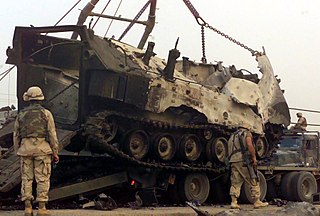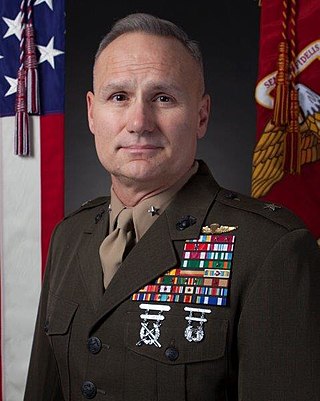
The United States-led invasion of the Republic of Iraq was the first stage of the Iraq War. The invasion phase began on 19 March 2003 (air) and 20 March 2003 (ground) and lasted just over one month, including 26 days of major combat operations, in which a combined force of troops from the United States, the United Kingdom, Australia and Poland invaded Iraq. Twenty-two days after the first day of the invasion, the capital city of Baghdad was captured by coalition forces on 9 April 2003 after the six-day-long Battle of Baghdad. This early stage of the war formally ended on 1 May 2003 when U.S. President George W. Bush declared the "end of major combat operations" in his Mission Accomplished speech, after which the Coalition Provisional Authority (CPA) was established as the first of several successive transitional governments leading up to the first Iraqi parliamentary election in January 2005. U.S. military forces later remained in Iraq until the withdrawal in 2011.

The First Battle of Fallujah, code-named Operation Vigilant Resolve, was an operation against militants in Fallujah as well as an attempt to apprehend or kill the perpetrators of the killing of four U.S. contractors in March 2004.

The Second Battle of Fallujah, initially codenamed Operation Phantom Fury,Operation al-Fajr was an American-led offensive of the Iraq War that lasted roughly six weeks, starting 7 November 2004. Marking the highest point of the conflict against the Iraqi insurgency, it was a joint military effort carried out by the United States, the Iraqi Interim Government, and the United Kingdom. Within the city of Fallujah, the coalition was led by the U.S. Marine Corps and U.S. Army, the battle was later described as "some of the heaviest urban combat U.S. military have been involved in since the Battle of Huế City in Vietnam in 1968".

Task Force 20 is a temporary combat force designation that has been used several times and may still be used by separate parts of the United States armed forces. The longer-established iteration was a part of the United States Second Fleet in the Atlantic from after the Second World War. This was part of the formal United States Military Communications-Electronic Board system.

Haditha is a city in the western Iraqi Al Anbar Governorate, about 240 km (150 mi) northwest of Baghdad. It is a farming town situated on the Euphrates River at 34°08′23″N42°22′41″E. Its population of around 46,500 people, predominantly Sunni Muslim Arabs. The city lies near the Buhayrat al Qadisiyyah, an artificial lake which was created by the building of the Haditha Dam, the largest hydroelectric facility in Iraq.

3rd Battalion, 1st Marines (3/1) is an infantry battalion in the United States Marine Corps based out of Camp Horno on Marine Corps Base Camp Pendleton, California. Nicknamed the "Thundering Third", the battalion consists of approximately 1,200 Marines and Sailors and falls under the command of the 1st Marine Regiment and the 1st Marine Division.

3rd Battalion, 3rd Marines, abbreviated as (3/3), was an infantry battalion of the United States Marine Corps, based out of Kaneohe, Hawaii. Known as either "Trinity" or "America's Battalion", the unit normally fell under the command of the 3rd Marine Regiment of the 3rd Marine Division. When fully manned, the unit consisted of approximately 1000 U.S. Marines and United States Navy Sailors. Like most 20th century model infantry battalions of the U.S. Marine Corps, 3rd Battalion 3rd Marines was made up of three rifle companies, and a Headquarters and Services (H&S) company. The battalion was originally formed at Marine Corps Base Camp Lejeune, North Carolina in 1942 and saw action on both Bougainville and Guam during World War II, where it was awarded its first Presidential Unit Citation and Navy Unit Commendation. Marines in the battalion were also awarded one Medal of Honor and seven Navy Crosses during the war.

The Haditha Dam or Qadisiya Dam is an earth-fill dam on the Euphrates, north of Haditha (Iraq), creating Lake Qadisiyah. The dam is just over 9 kilometres (5.6 mi) long and 57 metres (187 ft) high. The purpose of the dam is to generate hydroelectricity, regulate the flow of the Euphrates and provide water for irrigation. It is the second-largest hydroelectric contributor to the power system in Iraq behind the Mosul Dam.

The 36th Commando Battalion is one of several Iraqi s-pecial operations forces units created after the fall of the Saddam Hussein. Originally part of the Iraqi Special Operations Forces Brigade, the unit has a role comparable to that of the United States Army Rangers. The unit is now designated as the 1st Commando Battalion, part of the 1st Special Operations Brigade.

The Battle of Nasiriyah was fought between the US 2nd Marine Expeditionary Brigade and Iraqi forces from 23 March to 2 April 2003 during the US-led invasion of Iraq. On the night of 24–25 March, the bulk of the Marines of Regimental Combat Team 1 passed through the city over the bridges and attacked north towards Baghdad. However, fighting continued in the city until 1 April when Iraqi resistance in the city was defeated.

The Battle of Ramadi was fought in the spring of 2004, during the same time as the First Battle of Fallujah, for control of the capital of the Al Anbar Governorate in western Iraq. A coalition military force consisting of the 2nd Battalion, 4th Marines were stationed to defend the city from an insurgent assault.

The Battle of Haditha took place between U.S. forces and Ansar al-Sunna in early August 2005 on the outskirts of the town of Haditha, Iraq, which was one of the many towns that were under insurgent control in the Euphrates River valley during 2005.

The Anbar campaign consisted of fighting between the United States military, together with Iraqi security forces, and Sunni insurgents in the western Iraqi governorate of Al Anbar. The Iraq War lasted from 2003 to 2011, but the majority of the fighting and counterinsurgency campaign in Anbar took place between April 2004 and September 2007. Although the fighting initially featured heavy urban warfare primarily between insurgents and U.S. Marines, insurgents in later years focused on ambushing the American and Iraqi security forces with improvised explosive devices (IEDs), large scale attacks on combat outposts, and car bombings. Almost 9,000 Iraqis and 1,335 Americans were killed in the campaign, many in the Euphrates River Valley and the Sunni Triangle around the cities of Fallujah and Ramadi.

Joint Special Operations Command Task Force in the Iraq War was a joint American and British special operations unit, of which little is publicly known. It is described as a "hunter-killer team" with its core made up of the United States Army's 1st Special Forces Operational Detachment-Delta and the 75th Ranger Regiment, as well as the United States Naval Special Warfare Development Group and members of the United States Air Force's 24th Special Tactics Squadron, all under Joint Special Operations Command (JSOC) and elements from the United Kingdom Special Forces, including the Special Air Service, Special Boat Service (SBS), Special Reconnaissance Regiment (SRR), 18 (UKSF) Signal Regiment and the Special Forces Support Group (SFSG). The unit was reported to be responsible for the cross border raid into Syria from Iraq in October 2008 that resulted in eight deaths including Abu Ghadiya, along with several US operations in the Horn of Africa targeting al-Qaeda.

The Marine Raider Regiment (MRR), formerly known as the Marine Special Operations Regiment (MSOR), is a special operations force of the United States Marine Corps, which is a part of Marine Corps Special Operations Command (MARSOC). Renamed for its predecessor, the World War II Marine Raiders, this unit is the principal combat component of MARSOC, which is the Marine Corps' contribution to the United States Special Operations Command (USSOCOM).
The War on Terror is the campaign launched by the United States of America in response to the September 11 attacks against organizations designated with terrorism. The campaign, whose stated objective was eliminating international terrorism, began in 2001. The following is a timeline of events linked to the War on Terror.

Operation Sayeed also known as Operation Hunter in English, was a series of operations conducted in western Al Anbar Governorate by the United States Marine Corps in 2005. It was an umbrella operation, consisting of at least 11 named operations between July 2005 to December 2005. The purpose was to drive Al-Qaeda in Iraq forces from the Western Euphrates River Valley. Some parts of Operation Sayeed were Operation Steel Curtain and Operation Iron Fist.

Ramadi, the capital of Iraq's Al Anbar Governorate, was under U.S. military occupation during the Iraq War. It was a focal point of Iraqi insurgency, which erupted into open armed conflict in 2004 and in 2006, part of the Iraq War in Anbar Province. Operation Murfreesboro was a U.S. offensive in February 2007 intended to cut off the Ma'Laab district of eastern Ramadi from the rest of the town in order to drive out Zarqawi's Al-Qaeda in Iraq.

Norman Lee "Norm" Cooling is a retired Brigadier General in the United States Marine Corps, who most recently served as the Assistant Deputy Commandant for Plans, Policies & Operations, Headquarters, United States Marine Corps and who previously served a number of roles during deployments in support of Operation Enduring Freedom in Afghanistan and Operation Iraqi Freedom, notably as the battalion commander of 3rd Battalion, 3rd Marine Regiment.

The Battle of Haditha Dam took place in 2003. During the 2003 invasion of Iraq, United States Army Rangers seized the Haditha Dam on 1 April in order to prevent it from being destroyed. Destruction of the dam would have significantly affected the functioning of the country's electrical grid and could cause major flooding downstream from the dam.

















